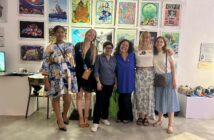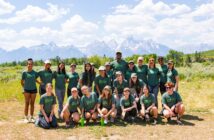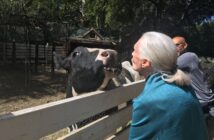In 1960, anthropologist Louis Leakey sent Dr. Jane Goodall, a 26 year old native of England with no college degree or scientific experience, to Africa with a mission: learn everything she could about wild chimpanzees. Leakey hoped that information on chimpanzees would shed light on human’s evolutionary past. But for Dr. Goodall, studying the chimpanzees just to learn more about them was reward enough. She established the Gombe Stream Research Center to aid her in the task, and 55 years after stepping onto the shore of Lake Tanganyika in modern-day Tanzania, Dr. Goodall’s study is still carried out by the Jane Goodall Institute. This Q&A with Dr. Goodall looks back on the last 55 years at Gombe, from the very beginning to her thoughts on the center’s future.
The Q&A is divided into two parts, with this first part focusing on the origins of Dr. Goodall’s work at Gombe and her personal experiences there over the years. Read part 2 here.
When you first arrived at Gombe, your mother was with you because the British government insisted they would not allow a young woman to go alone into the bush of Africa. Were you upset by Britain’s insistence that your mother had to accompany you to Africa? What was it like when the two of you first arrived at Gombe?
It was really nice to have my mother come with me on this first visit to Gombe. I was in Nairobi ahead of her, and we shared the journey to Kigoma, over rough roads, in a very overloaded Land Rover. And then we arrived finally in Kigoma to find that the Congolese had revolted in what was then the Belgian Congo, and Kigoma was full of Belgian refugees.
When we were finally allowed to set off, by boat, for Gombe, things had come to seem rather unreal! I looked up at the thickly forested valleys and wondered how I was going to find the chimpanzees I was supposed to study.
During the early months , when the chimpanzees vanished into the undergrowth at sight of the strange white ape, it was wonderful to have my mother there. I would return to camp as darkness fell, often depressed, and Mum boosted my morale, pointing out all the behaviours I was actually observing from “The Peak” (from where I could look out over two valleys and, after a short walk, over a third).
Moreover, she started a “clinic” – handing out simple medications like aspirins and Epsom salts, administering saline drips and cleaning and bandaging wounds. She thus established really good relations with the fishermen who came from surrounding villages, right from the start.
She made some amazing cures. I found out later that she was known as a “white witch doctor!”
It was sad that she left just after I saw termiting for the first time. I had no one with whom to share the excitement. I missed her – but by then I was becoming more and more at home in the forests I came to love.
What was the biggest challenge you faced in the first year of the study. When did you feel you’d finally overcome the challenge?
One of the really hard times was the first four months when the chimpanzees ran from me in fear. I was worried that the six months of funding would run out, and I would let Louis Leakey down. That period ended when I saw David Greybeard fishing for termites.
But in a way the rainy and very humid May and June of my first year were almost as bad. I had expected the rainy season to be over by April, but the occasional torrential downpours had yet to cease. Worse, the air was oppressive. I could not breathe on my long treks up the mountainsides and the only way to escape the thick humidity surrounding me was to climb a tree. Small fevers were recurrent, making the humidity and the climbs unbearable. And although the chimps were growing accustomed to me at this point, I found it difficult to find them because they had split from their large, noisy feeding groups into small, quiet groups of two to six. These new groups could walk through the forest without making a sound.
But eventually the humidity of the rainy season passed, my fevers subsided and I was able to observe the chimpanzees again. My spirits were lifted, particularly when I discovered that I could move down from the Peak and into the valleys to watch the chimpanzees feeding on the bountiful figs that had sprung up during the rains. The chimps’ aggression towards me, which had followed their initial flights of fear when they saw me, subsided, and I was finally able to get close to the beings I had come so far to study.
What was your opinion of chimpanzees during the dark days of civil war and infanticide in the 1970’s?
It was shocking to me when we discovered that chimpanzees, like us, have a dark side to their nature. That they can be violent and brutal. We saw adult males patrolling the boundaries of their territory, searching for sight and listening for sound of their neighbours. If an individual “stranger” from a neighbouring community was found, he or usually she was subjected to a brutal assault and usually died of wounds sustained. Only young females, who had not yet given birth, were spared – they were actively persuaded to follow the males back into their home community. Then came the “Four Year War” – a kind of primitive warfare, more like gang warfare. This started two years after the main study community divided. Over a period of months, seven adult males and three females, began to spend less time in the northern part of their range. Eventually they established their territory in the south of the area which, originally, all the chimpanzees had shared. Then started what I have called the Four Year War – when males of the larger community in the north (the Kasakela community) began penetrating the territory of the newly established Kahama community in the south. Over the four years every one of the seven Kahama males was viciously attacked and left to die of his wounds. The three adult females were also killed.
What was so shocking about these killings was the fact that previously the attackers and the attacked had lived peacefully together. Then, after two years separation, they were treated as strangers.
It was during that same time that Passion, and her adult daughter Pom, began to attack mothers of newborn infants in their own community. Their goal was to seize the infants and eat them. In other words, they showed cannibalistic behavior. Between them they may have killed all 10 infants born during a two year period. The attacks only stopped when both Passion and Pom delivered babies of their own.
We still do not totally understand this unpleasant behavior. I felt I hated Passion and Pom at the time. Unfortunately, we have seen the same behavior in other mothers over the succeeding years. These violent behaviours – boundary attacks, the Four Year War and cannibalism – forever changed my view of chimpanzees: I had thought they were so like us, but nicer. This turned out not to be true – but it is almost certain that chimpanzees cannot fully comprehend the pain and suffering they inflicted on their victims. Nor can they plan physical and mental torture. Only we are capable of true evil.
You faced many dangerous moments at Gombe over the years: sometimes chimpanzees threatened or attacked you; you were pregnant when the chimpanzees had a polio outbreak; and once you had 40 rebels come to your camp and kidnap students. What was the scariest moment for you in your time at Gombe, and how did you overcome it?
The kidnapping in 1975 was the most terrifying. It happened in the middle of the night. Soon after I had gone to bed, a student arrived to say that there was an emergency – that four students had been captured and taken off by armed men. Later we learned it was Zaire rebels who had crossed Lake Tanganyika to kidnap my students. It was a night of terror. None of us, my students and field staff and I, knew what was happening. We had to pack up and leave Gombe. And, until one of the students was sent back, with demands for money from the kidnappers, we did not know whether the kidnapped students were alive or dead. After that Gombe was no longer the oasis of peace in an increasingly turbulent world. Even after all the students were released it took a long time before I could hear the sound of a boat engine at night without a recurrence of the terrible fear.
It was also a terrifying moment when I was perched on the edge of a precipice, holding onto a tree, and Frodo (the adult male who went out of his way to knock me over and stamp on me) charged down towards me. I was sure that I was living my last moments! But he did not touch me. This sort of thing happened twice more with Frodo. Bill Wallauer had the same experience a couple of times. And I had the same thing happen once with Goblin (who also often pushed me over), when I was on a very steep skiddy slope with a sheer drop below. Bill and I, therefore, know that when these males “attack” us they are not trying to harm us, but merely intimidate us. Impress us with their strength. If it were not so, we would both be dead!
What was the most significant moment of your study with the chimps, personally and scientifically?
My early discovery of chimpanzee tool making and tool using was immensely exciting. This was when first David Greybeard, and then his companion, Goliath, not only used grass stems as tools, but sometimes picked leafy twigs – before they could use this as a tool they had to carefully strip off the leaves. This is primitive tool-making. It startled the scientific community. At that time we humans were defined as “Man the tool-maker.” When I told Louis Leakey (by telegram) he said we would have to redefine “Man,” redefine “tool” or accept chimpanzees as human! The fact that they sometimes hunt and eat small mammals, such as baby monkeys or bushbuck, or baby birds was also very surprising to scientists.
What I have found most fulfilling personally was to observe the development of infants, and follow the development of the relationship between mothers and their offspring. To gradually realize the tremendous importance of the early years of experience in chimpanzee society, as in our own. And to discover that there are good and bad mothers in the chimp world as well.
Subsequently I was fascinated to compare the development of infants Flint and Goblin (the first two I could study from birth onwards) with that of my own son, Grub.






